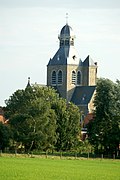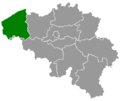You can help expand this article with text translated from the corresponding article in Dutch. (April 2020)Click [show] for important translation instructions.
|
Mesen | |
|---|---|
City and municipality | |
 | |
| Coordinates: 50°46′N02°54′E / 50.767°N 2.900°E | |
| Country | Belgium |
| Community | Flemish Community |
| Region | Flemish Region |
| Province | |
| Arrondissement | Ypres |
| Government | |
| • Mayor | Sandy Evrard (MLM) |
| • Governing party/ies | Mesense Liberalen/Libéraux Messinois (MLM) |
| Area | |
• Total | 3.6 km2 (1.4 sq mi) |
| Population (2022-01-01) [1] | |
• Total | 1,062 |
| • Density | 300/km2 (760/sq mi) |
| Postal codes | 8957 |
| NIS code | 33016 |
| Area codes | 057 |
| Website | www.mesen.be |
Mesen (Dutch: [ˈmeːsə(n)] ⓘ ; French : Messines [mɛsin] , historically used in English) is a municipality and city [2] located in the Belgian province of West Flanders. On 1 January 2006, Mesen had a total population of 988. The total area is 3.58 km2 which gives a population density of 276 inhabitants per km2.
Contents
The municipality comprises only one main settlement, the town of Mesen proper. An exclave to the west of the main territory is surrounded by the municipalities of Heuvelland and Comines-Warneton.

Villages neighbouring the municipality:
- a. Wijtschate (in the municipality of Heuvelland)
- b. Warneton (in the municipality of Comines-Warneton)
- c. Ploegsteert (in the municipality of Comines-Warneton)
Mesen is the smallest city in Belgium. It is a municipality with language facilities.
Mesen is twinned with Featherston in New Zealand in part due to the location of the New Zealand World War I Memorial, which has annual Anzac Day commemorations on 25 April.










